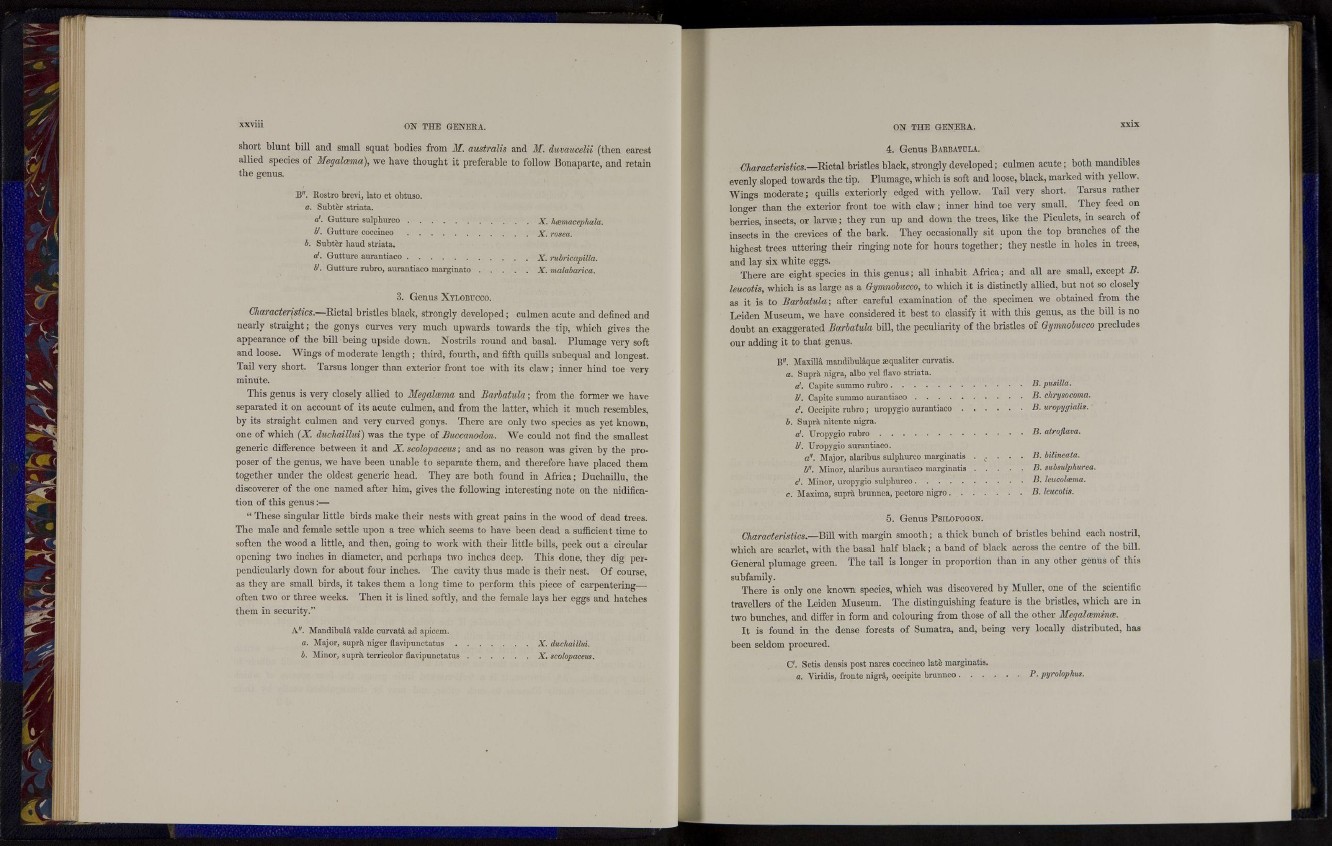
xxviii ON THE GENERA.
short blunt bill and small squat bodies from M. australis and M. duvaucelii (then earest
allied species of Megalamia), we have thought it preferable to follow Bonaparte, and r e t a in
t h e genus.
B". Rostro brevi, lato et obtuso.
a. Subtér striata.
a'. Gutture sulphureo X. fanmacephala.
b'. Gutture coccíneo X. rosea.
b. Subtér liaud striata.
al. Gutture aurantiaco X rubricapilla.
b1. Gutture rubro, aurantiaco margínate X. malabarica.
3. Genus XYLOBUCCO.
CJiaracterístics.—Bictal bristles black, strongly developed; culmen acute and defined and
nearly s t r a i g h t ; the gonys curves very much upwards towards the tip, which gives t he
appearance of t h e bill being upside down. Nostrils round and basal. Plumage very soft
and loose. Wings of moderate l e n g t h ; third, fourth, and fifth quills subequal and longest.
Tail very short. Tarsus longer than exterior front toe with its claw; inner hind toe very
minute.
This genus is very closely allied to Megalcema and Barbatula; from t h e former we have
separated i t on account of its a c u t e culmen, and from the latter, which it much resembles,
by its straight culmen and very curved gonys. There are only two species as yet known,
one of which (X. duchaillui) was the type of Buccanodon. We could not find the smallest
generic difference between it and X. scolopaceus; and as no reason was given by t h e proposer
of t h e genus, we have been unable to separate them, and therefore have placed them
together under t h e oldest generic head. They are b o t h found in Africa; Duchaillu, t he
discoverer of t h e one named after him, gives t h e following interesting note on t h e nidification
of this g e n u s :—
" These singular little birds make their nests with great pains in t h e wood of dead trees.
The male and female settle upon a tree which seems to have been dead a sufficient time to
soften the wood a little, and then, going to work with their little bills, peck out a circular
opening two inches in diameter, and perhaps two inches deep. This done, they dig perpendicularly
down for about four inches. The cavity thus made is their nest. Of course,
as they are small birds, it takes them a long time to perform this piece of carpentering—
often two or t h r e e weeks. Then it is lined softly, and the female lays her eggs and hatches
them in security."
A". Mandíbula valde curvatá ad apiccm.
a. Major, suprk nigcr flavipunetatus X. duchaillui.
b. Minor, supra terricolor flavipunetatus X. scolopaceus.
ON THE GENERA. xxix
4. Genus BARBATULA.
Characteristics.—Bictal bristles black, strongly developed; culmen a c u t e ; both mandibles
evenly sloped towards t h e tip. Plumage, which is soft and loose, black, marked with yellow.
Wings moderate; quills exteriorly edged with yellow. Tail very short. Tarsus rather
longer than the exterior front toe with claw; inner hind toe very small. They feed on
berries, insects, or larvae; they run u p and down t h e trees, like t h e Piculets, in search of
insects in the crevices of t h e bark. They occasionally sit upon t h e t o p branches of t h e
highest trees uttering their ringing note for hours together; they nestle in holes in trees,
and lay six white eggs.
There are eight species in this genus; all inhabit Africa; and all a r e small, except B.
leucotis, which is as large as a Ggmnobucco, to which it is distinctly allied, but not so closely
as it is t o Barbatula; after careful examination of t h e specimen we obtained from the
Leiden Museum, we have considered it best to classify it with this genus, as t h e bill is no
doubt an exaggerated Barbatula bill, t h e peculiarity of t h e bristles of Gymnobucco precludes
our adding i t to t h a t genus.
B". Maxilla mandibulaque aequaliter curvatis.
a. Supril nigra, albo vcl flavo striata.
a'. Capite summo rubro B. pusilla.
V. Capite summo aurantiaco B. chrysocoma.
c1. Occipite rubro ; uropygio aurantiaco B. uropyi/ialis.
b. Supra nitcnte nigra.
a'. Uropygio rubro B. atroflava.
V. Uropygio aurantiaco.
a". Major, alaribus sulphurco marginatis . . . . . B. bilineata.
b". Minor, alaribus aurantiaco marginatis B. subsulphurea.
d. Minor, uropygio sulpbureo B. leucolama.
c. Maxima, supra brunuea, pectorc nigro B. leucotis.
5. Genus PSILOPOGON.
Characteristics.—Bill with margin smooth; a thick bunch of bristles behind each nostril,
which are scarlet, with the basal half black; a band of black across the centre of t h e bill.
General plumage green. The tail is longer in proportion than in any other genus of this
subfamily.
There is only one known species, which was discovered by Muller, one of the scientific
travellers of t h e Leiden Museum. The distinguishing feature is t h e bristles, which are in
two bunches, and differ in form and colouring from those of all t h e other Meqalmmina?.
I t is found i n t h e dense forests of Sumatra, and, being very locally distributed, h as
been seldom procured.
C. Setis densis post nares coccineo late marginatis.
a. Viridis, frontc nigra, occipite brunneo P. pyrolophus.